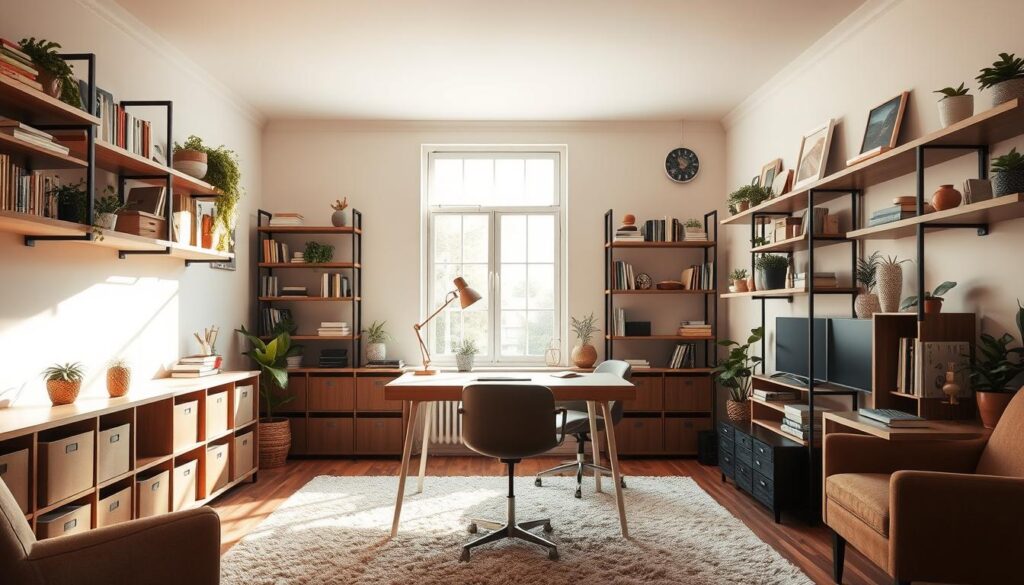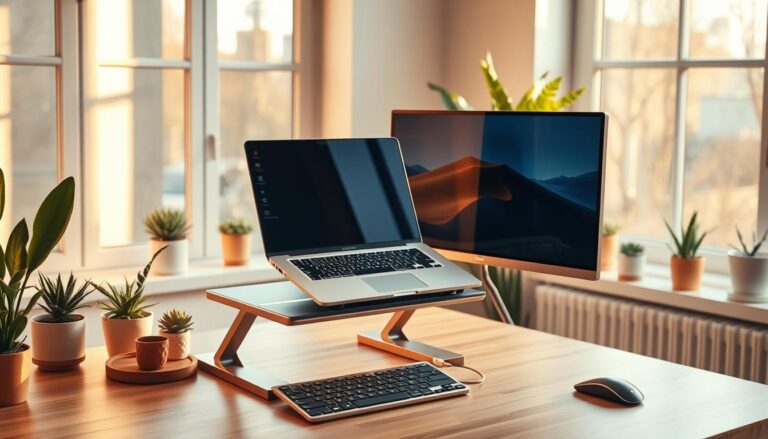Lighting Solutions for a Productive Home Office Environment
Creating the perfect home office lighting is easy and affordable. Start by placing your desk near a window for natural light. This natural light helps you stay focused and energized.
Smart desk lights like the Edge Light 2.0 reduce glare and eye strain. They have 5 adjustable pivots for the best view.
When setting up your home office, lighting is key. Cool bulbs in the 5000K-6500K range help with screen work. Task lights with 1000 lumens improve detail clarity.
Combine overhead lights with desk lamps for a balanced look. Try the SKYLEO LED desk lamp or the Dyson Solarcycle Morph. This lamp adjusts to your day’s needs via an app.
It’s important to find the right balance. Use floor lamps and LED strips for mood lighting. Add a monitor light bar to fight glare. Even affordable options like the IKEA Hektar Work Lamp or the Louis Poulsen NJP Mini can make a big difference.
Let’s explore how to create a space that keeps you energized without breaking the bank.
Key Takeaways
- Position desks near windows to maximize natural light and cut energy costs.
- Task lighting like the Edge Light 2.0’s 5-way adjustability reduces eye strain by 51%.
- Mix overhead lamps and LED strips for ambient light while prioritizing 700-1000 lumens for reading.
- Budget-friendly options like the Flos Kelvin or Anglepoise Type 75 Desk Lamp offer style and function.
- Smart lamps like Dyson’s Solarcycle Morph sync with your schedule for automatic brightness adjustments.
Importance of Home Office Lighting
Ever notice how a sunny workspace lifts your mood? Great home office lighting isn’t just about brightness—it’s your daily power-up. When your eyes aren’t straining, you focus longer and feel more energized. Let’s see why this matters.
Science backs this up. Cornell University founds show natural light slashes eyestrain and headaches, making your work easier. But how does this translate to your setup? Let’s break it down.
The Link Between Light and Productivity
Light acts as your invisible motivator. When your desk has even, glare-free lighting for productivity, your brain stays sharp. Dim areas slow focus—try upgrading if you hit an afternoon slump.
How Lighting Affects Mood
Dark spaces drag your energy. Bright, warm tones mimic sunrise, while cooler whites boost alertness. A study found 43% of workers felt gloomy in dim rooms. Even small lamps make a difference.
Natural Light vs. Artificial Light
- Natural light: Free and full-spectrum. Position desks near windows to catch morning rays.
- Artificial options: LED panels or adjustable lamps mimic daylight when sunlight’s gone. They’re budget-friendly and long-lasting.
“Follow the 20-20-20 rule: every 20 minutes, look at something 20 feet away for 20 seconds. It’s a quick way to refresh your eyes.”
Mix both types for the best results. Even small changes like facing a window or adding a desk lamp can transform your space—without a big budget!
Choosing the Best Desk Lamps
Creating a workspace that supports your needs starts with the right desk lamp. Look for options that balance style and function. Key features like adjustability and brightness matter most. Let’s break down what to prioritize.
Key Features of a Good Desk Lamp
Adjustable brightness and direction are top priorities. Ergonomic desk lamps with a gooseneck design—like the TW Lighting Ivy LED—offer 360-degree movement, reducing eye strain. Opt for lamps with at least 1000 lumens for detailed tasks. Features like USB ports or touch controls add convenience. A high CRI (above 90) ensures colors look true to life.
Top Brands for Desk Lamps
- TW Lighting Ivy LED: 500-lumen brightness, 3 brightness levels, USB port
- Edge Light 2.0: 5 pivot points, customizable color temperature
- Video Conference Kit: Soft light for clear video calls
Adjustable vs. Fixed Desk Lamps
Flexible lamps adapt to your setup. Adjustable models like gooseneck designs suit varied tasks. Fixed lamps offer simplicity but less flexibility. Choose based on your workspace. For left-handed users, position the lamp on your dominant side to avoid shadows.
Types of Lighting for a Home Office
Creating a cozy home office begins with knowing the three main types of home office lighting: ambient, task, and accent. These layers help make your space both useful and welcoming. Let’s explore how each type fits into your office.

Ambient Lighting: The Foundation
Ambient light is the heart of your room. It offers overall light, softening shadows and setting a cozy tone. A ceiling light or a floor lamp is perfect here. Plus, natural light from windows can energize and sharpen your focus.
Task Lighting: Focus on the Work
Task lights are for where you need clear focus. Desk lamps like the Edge Light 2.0 or the BenQ e-Reading Lamp reduce glare and let you adjust the brightness. Look for ones with adjustable arms and dimming for your specific needs.
Accent Lighting: Add Personality
Accent lights add style and warmth. Try LED strips under shelves or a stylish floor lamp in a corner. The Govee Smart LED Strips add color and can be controlled by your phone. Even a small accent light can make your workspace feel like home.
Begin with what you have and add smart choices like the TIJN Blue Light Blocking Glasses or a Cricket Spotlight. Mixing these types turns a room into a productive and creative haven, all without spending a lot.
LED Lighting Options for Home Offices
LED lighting is more than a trend; it’s a smart choice for your workspace. It saves money, reduces eye strain, and keeps your office running well. Let’s see how LEDs can change your space.
Why LEDs Are a Smart Choice
LEDs beat older bulbs in every area. They use 80% less energy than incandescent bulbs, saving on bills. Plus, they last up to 25,000 hours, meaning fewer replacements. And, they run cooler, making them safer for long work hours.
Save Money with Energy-Efficient Options
Energy-saving lamps like the BenQ e-Reading LED Desk Lamp fit your space perfectly. Its ambient sensor adjusts brightness for you, and it has warm and cool modes for focus or chill time. This smart feature cuts down on energy waste and your bills over time.
Top Picks for Your Desk
- BenQ e-Reading Lamp: Two lighting modes, sensor tech, $80–$100.
- JOOFO Floor Lamp: Three color temps, remote control, great for large desks.
- O’Bright Portable Lamp: Cordless, 48-hour battery life, ideal for tight budgets.
Look for adjustable features like the Tw Lighting Ivy Desk Lamp’s 360-degree neck or the Brightech Leaf Lamp’s dimmer switch. Even the Govee LED Strip Lights (32.8ft) are good for under-cabinet or accent lighting.
Ready to upgrade? LEDs offer both style and savings. Start with a desk lamp and add more as you go. Your eyes and wallet will appreciate it.
Smart Lighting Solutions
Smart lighting is more than a trend; it’s a big change for your home office. Modern lighting systems let you change your space easily and save on energy. Imagine changing your desk’s light with your voice or dimming it with your phone. These systems make life easier and don’t cost a lot.
Benefits of Smart Lighting
- Control lighting with apps, voice assistants, or touch.
- Schedule lights to turn on/off automatically.
- Adjust colors and brightness for focus or relaxation.
- Save energy with energy-efficient office lamps that dim or turn off when not in use.
Best Smart Bulbs for Home Offices
Start with affordable options like Philips Hue or Wyze bulbs. Philips Hue bulbs change the mood with 16 million colors. Wyze bulbs are cheaper but offer bright, clear light. Both work with voice commands and most fixtures.
How to Set Up Smart Lighting
Begin with a starter kit—add bulbs first, then expand later. Most systems connect via Wi-Fi or Bluetooth, and setup takes minutes. Pair bulbs with a voice assistant like Alexa or Google Home for hands-free control. Even one smart bulb can change your space, and you can add more anytime.
Color Temperature and Productivity
Did you know the right light color can sharpen focus or calm your mind? Let’s explore how color temperature shapes your workspace using lighting for productivity principles.
Understanding Kelvin Ratings
Color temperature is measured in Kelvins (K). Lower numbers mean warmer, yellower light (2700K-3000K). Higher numbers bring cooler, bluer tones (5000K+).
Think of it like sunrise to noon to sunset. A 4000K bulb sits in the middle, balancing warmth and brightness.
How to Choose the Right Color Temperature
- Focus tasks (typing, spreadsheets): 4000K-5000K for alertness
- Creative work (design, brainstorming): 3000K-4000K for a calm yet engaged vibe
- Relaxation or evening downtime: 2700K-3000K to wind down
Many affordable LED lamps like the Edge Light 2.0 let you toggle between settings. No need for pricey setups—adjust as you work!
Warm vs. Cool Light for Different Tasks
Cool light (5000K+) boosts alertness but can strain eyes over long hours. Warm tones (2700K) feel cozy but may slow focus. For most home offices, 4000K is a sweet spot.
Pair it with dimmers or adjustable bulbs to match your rhythm.
“A 4000K color temperature reduces eye strain while keeping you energized.” – Lighting Design Institute
Remember: Mix and match. Use cooler light at your desk and warmer tones in lounge areas. Small tweaks in color temperature can make your space feel like it’s tailored just for you.
Designing Your Home Office Lighting Layout
Creating the right home office lighting layout starts with small, smart choices. Let’s turn your workspace into a hub of focus and comfort with these simple steps.
Tips for Effective Lighting Placement
- Position adjustable desk lights opposite your dominant hand. Right-handed? Place your lamp on the left to avoid shadowy.
- Avoid glare on screens by keeping lights away from monitor fronts. Try the Mo desk lamp with its flexible arm for precise angle adjustments.
- Use lighter desk surfaces to bounce natural light around the room. Pair with window positioning that avoids direct glare during video calls.
Layering Different Lighting Sources
Think of lighting like layers in a painting. Start with ambient light from overhead fixtures, then add task-focused adjustable desk lights. For example, the Analog Task Light offers adjustable brightness for close work. Finish with accent touches like the Crick Triple Spotlight for style without breaking the bank.
Creating a Well-Balanced Work Environment
Mix affordability with function. The Utopia rechargeable lamp costs under $30 yet delivers adjustable brightness. Floor lamps like the Aesop model free up desk space. Even small changes—like swapping in an LED bulb—can transform your space.
Test how light shifts through the day. Adjust your adjustable desk lights at midday versus evening. Tiny tweaks make a big difference in comfort and focus.
Every space is unique. Start with what you have and build gradually. A $25 desk lamp can be your first step toward a brighter, better workspace.
Managing Glare and Shadows
Unwanted glare and harsh shadows don’t have to ruin your workspace. Small changes can make a big difference. Start by identifying light sources causing reflections or dark spots—then try these easy fixes.
Techniques to Reduce Glare
- Position adjustable desk lights at a 30-45 degree angle to avoid screen reflections.
- Use sheer curtains or frosted film on windows to soften natural light.
- Opt for ergonomic desk lamps with adjustable arms—like the BenQ ScreenBar—to direct light away from screens.
Using Blinds and Shades Effectively
Blinds aren’t just for privacy—they’re your ally against glare. Adjust slats to let in light without harsh reflections. For maximum control, choose blinds with tilt options.
Combine them with task lighting to balance brightness and shadow-free zones.
The Importance of Positioning Your Lamp
Where you place your lamp matters. Position adjustable desk lights on your non-dominant side to avoid casting shadows. For video calls, use two light sources.
One as a key light (like an LED desk lamp) and another as fill light to brighten under-eye areas. This setup boosts clarity and reduces unflattering shadows.
Enhancing Aesthetic with Lighting
Creating a home office that’s both functional and inspiring starts with the right lighting. Today’s best desk lamps are more than just basics. They’re designed to fit your style perfectly.
Decorative options like the Himalayan salt lamp from The Body Source add warmth without breaking the bank. Pairing these with sleek choices like the Philips Striker Table Lamp or Philips Cosmos Desk Light ensures your desk stays productive and stylish. These lamps combine adjustable arms and energy-efficient LEDs to match your tasks, all while fitting any décor.
Modern desk lamps like the Philips Jazz Table Lamp or the minimalist Philips Hint model use bold designs to make a statement. Their affordable prices let you mix and match without overspending. Layer in soft string lights behind shelves or along walls to set the mood—perfect for brainstorming or unwinding after work. Philips Orbit and Air lamps offer compact yet powerful lighting that doesn’t take up desk space.
Whether you choose bold Philips Smart WiFi models or classic minimalist designs, modern office lighting helps tie your space together. Adjustable brightness on lamps like the Philips Squire or Hero Desk Lamp ensures comfort while keeping your style on point. Every detail matters, from a desk lamp’s shape to how it interacts with your wall art or plants.
Investing in lighting that reflects your taste doesn’t mean sacrificing function. Philips’ discounted models like the Ornate Table Lamps prove you can have both. Let these pieces turn your corner of the house into a spot where productivity meets personal expression—all within budget. Your workspace deserves to feel like your favorite place to create.
FAQ
How can I improve my home office lighting without spending a lot of money?
What features should I look for in the best desk lamps?
Why is natural light better than artificial light for productivity?
What is the ideal color temperature for a home office?
How can I manage glare on my computer screen?
What are some top brands for ergonomic desk lamps?
Can smart lighting really help with productivity?
Are LED lamps really more energy-efficient?
How can decorative lighting enhance my workspace?
What’s the advantage of using different lighting layers in my office?










